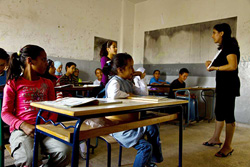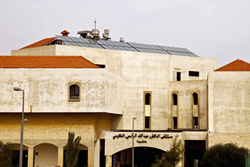 With Lebanon’s chronic power shortages, classes at the Rajam Issa public school are often plunged into darkness during the winter.
With Lebanon’s chronic power shortages, classes at the Rajam Issa public school are often plunged into darkness during the winter.
In the remote northeastern district of Akkar, teachers and students are hoping this winter will be the first of many years when the lights stay on. “Electricity is the lifeline of the school,” said head teacher Ibrahim Salame of the Rajam Issa public school, complaining of frequent and prolonged power cuts. (Photo: Hugh Macleod/IRIN)
“During the winter if the power goes out and it’s dark we just teach in the dark,” said Salame. “What usually takes one session to explain using a projector takes two hours on the blackboard.”
It is hoped that by the end of November their classroom lights, projectors and photocopying machines will stay on during power cuts thanks to a set of rooftop photovoltaic panels producing renewable electricity from one of Lebanon’s most abundant natural resources, the sun.
“Lebanon has an average of 300 days of sunshine per year, yet we are not making sufficient use of it,” said Jihan Seoud from the Energy and Environment Program at the UN Development Program (UNDP) in Beirut.
“The government is looking to reform the electricity sector, but mostly on the supply side. We are working with government entities to reduce load on the demand side. Reducing demand means the government can spend less on electricity generation,” Seoud said.
Burden of oil imports
Lacking oil and gas resources, Lebanon imports some 97 percent of its energy needs as fossil fuel. Government efforts to modernize electricity infrastructure since the end of the Civil War in 1990 have been unable to keep pace with growing demand.
The solution, say many Lebanese environmentalists, is a combination of solar thermal power to heat water, and photovoltaic panels for back-up electricity. These can have a direct humanitarian impact.
“Renewable energy can have huge positive effects both directly and indirectly for humanitarian use. Solar water heaters (SWH) can substantially reduce the energy bills of healthcare and education facilities,” said Pierre Khoury, acting manager of the Lebanese Centre for Energy Conservation (LCEC) in the Ministry of Energy and Water (MEW). “It can also reduce poverty by reducing energy bills of poor people and creating ‘green jobs’.”
After the July War of 2006 further damaged Lebanon’s power infrastructure, including destroying 190 of the nearly 500 SWH units installed in south Lebanon and donated by China, UNDP and LCEC teamed up with the Spanish government to install solar water heaters in south Lebanon.
This was followed by the creation of the CEDRO project through the Lebanon Recovery Fund to promote energy efficient reconstruction of homes and public buildings.
With earlier donations from Sweden and Greece, the program has successfully installed or repaired over 500 SWH units and identified 180 public sector buildings in which to demonstrate renewable energy applications.
In a study of one SWH system installed in a typical family home in Marjayoun in South Lebanon, the LCEC found that over a year the system offset some 98.6 percent of the electricity previously needed to heat water.
Total annual savings were calculated to be US$195, though the real saving to the state power company totaled some $415 per system, providing a payback period of two years. The report concluded that around 290,000 SWH systems are needed to offset the need for a 100 MW power plant in Lebanon.
 Reduced Bills
Reduced Bills
Lebanese law does not allow citizens to generate their own electricity and connect to the grid, meaning solar photovoltaic electricity remains too costly for all but the largest private businesses, or for small schools like that in Rajam Issa which was given the system.
Heating water from the sun, however, has proved cost effective, and sales of SWH units tripled between 2005 and 2008, according to a survey by LCEC.
As well as is installing an initial 25 photovoltaic systems on the roofs of small schools in North Lebanon, the Bekaa valley and South Lebanon, CEDRO has constructed large-scale solar water heaters on four public hospitals. (Above, Dr Abdallah Rassi Hospital, the first public hospital in Akkar, now has 48 solar water heater panels on its roof)
One of these is the Abdallah Rassi Hospital, the first public hospital in Akkar, serving half a million people of whom, in the words of Ali Saada, its general manager, “400,000 are poor”.
With the hospital running at an annual deficit of around half a million dollars, said Saada, a third of which is spent on heating water via a diesel generator, the 48 SWH panels now on its roof will soon start making big savings, with a tangible benefit to patients.
“If we can save most of a third of our total running cost then the hospital could break even in three years, perhaps two if we get more patients,” said Saada. “Without the solar panels it would take us five. That means the intensive care department could open earlier and we could afford to buy a new scanner and other equipment.”



















